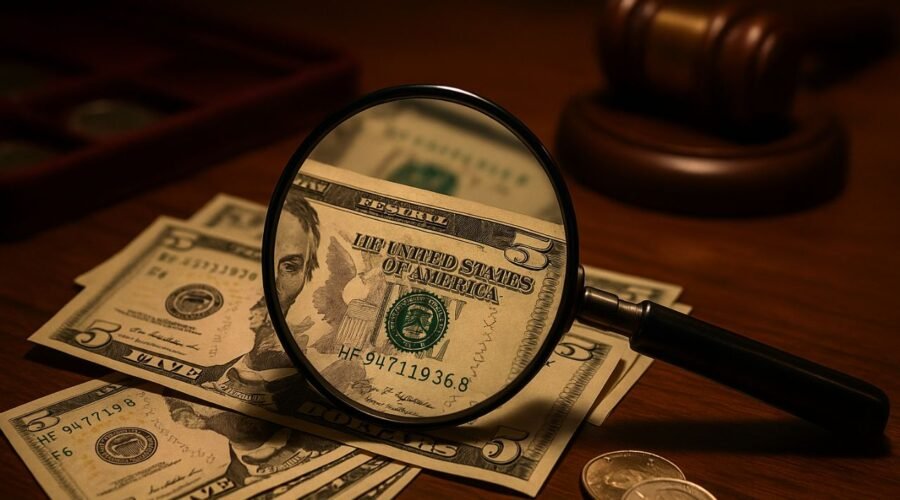Rare $5 Bill Error — Mismatched Serial Number Note Sells For $71,000 – Do You Have One?
On a genuine U.S. note, the two serials on the face must be identical (same prefix letter, eight digits, and suffix letter). A mismatched serial number occurs when the numbering wheels fall out of sync during the overprint stage, causing one corner to show a different digit (or digits) than the other.
Because the mistake is plainly visible without tools, this is one of the most dramatic and desirable error note types for collectors.
Quick Identification Checklist
Use this fast, at-home screening before you rush to sell:
- Compare both serials: look for any digit that doesn’t match.
- Confirm the prefix and suffix letters are the same on both serials.
- Check alignment of the Treasury seal and overprint; additional anomalies can raise value.
- Note the series year (e.g., 2017A) and district; some runs are better known to collectors.
- Condition matters: Gem Uncirculated examples outperform circulated wallet finds.
Value Drivers You Should Know
Four factors push a $5 bill error higher:
- Severity of the mismatch — a single off digit is valuable; multiple off digits or combined errors can be worth much more.
- Grade — crisp paper, original embossing, and no folds fetch premiums.
- Combination errors — e.g., mismatched + missing digit, misaligned seal, or other overprint issues.
- Certification — third-party grading (PMG/PCGS Banknote) verifies authenticity and boosts buyer confidence.
Realistic Price Guide (2025)
| Error Type | What It Looks Like | Typical Range | Top-End Potential* |
|---|---|---|---|
| Straight mismatched serial | One serial differs by 1+ digits | $800–$3,000 | $5,000+ |
| Mismatch + missing/partial digit | One serial incomplete plus mismatch | $2,500–$8,000 | $10,000+ |
| Multi-error mismatch | Mismatch plus shifted seal/overprint issues | $5,000–$15,000 | $20,000+ |
| Exceptional outliers | Rare combinations sometimes cited at headline levels | — | Up to five figures; $71,000 claims are exceptional |
*Assumes authenticated examples with strong eye appeal and high grade.
Step-By-Step: What To Do If You Find One
- Handle carefully — place the note in a Mylar currency sleeve; never clean or flatten it.
- Document both serials — take clear, glare-free photos of the face showing each number block.
- Get it graded — submit to a reputable service for authentication and encapsulation.
- Choose the right venue — for top pieces, consider a major auction house to reach serious bidders; for modest examples, a trusted dealer or currency marketplace works well.
- Set expectations — not every mismatch is a five-figure trophy; grade and combination errors drive the biggest results.
Common Pitfalls (Read Before You List)
- Fancy serial ≠ error: ladders, repeaters, and radars are collectible but not errors.
- Star notes aren’t automatically valuable—only if combined with a true production error or scarce run.
- Damage is not an error: ink smears, marker lines, or heat warping won’t pass grading as a production mistake.
- Unverified hype: be cautious of sensational screenshots; rely on certification and real market demand.
A genuine mismatched serial number $5 bill is more than a curiosity—it’s a proven $5 bill error that can bring serious money. While eye-popping headlines like $71,000 reflect exceptional, often multi-error trophies, many straightforward mismatches still sell for thousands when graded and marketed correctly.
If your two serials don’t match, protect the note, get it authenticated, and choose a selling venue that puts it in front of serious buyers. Your spare change might be a collector’s jackpot hiding in plain sight.
FAQs
How rare are true mismatched serial number notes?
They’re uncommon compared to everyday currency and highly sought after by error note collectors. The most competition appears for crisp, certified pieces with strong visual contrast between the two serials.
Does the series or district matter for value?
Yes. Certain modern series and press runs are more familiar to collectors, and notes from those runs can command stronger prices—especially in Gem grades or when combined with secondary overprint errors.
Can a circulated mismatch still be valuable?
Absolutely. A circulated example can still bring hundreds to low thousands if the mismatch is clear. But Gem Uncirculated examples authenticated by a grading service will generally realize the highest amounts.


Leave a Reply